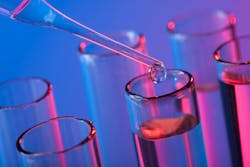UC Riverside Scientists Publish New PFAS Cleanup Method
University of California, Riverside press release
Chemical engineering and environmental scientists at the University of California, Riverside, recently published new methods to chemically break up per- and polyfluoroalkyl substances (PFAS) found in drinking water into smaller compounds that are essentially harmless.
According to a university press release by David Danelski, the patent-pending process infuses contaminated water with hydrogen, then blasts the water with high-energy, short-wavelength ultraviolet light. The hydrogen polarizes water molecules to make them more reactive, while the light catalyzes chemical reactions that destroy the pollutants, known as PFAS or poly- and per-fluoroalkyl substances.
This one-two punch breaks the strong fluorine-to-carbon chemicals bonds that make these pollutants so persistent and accumulative in the environment. In fact, the molecular destruction of PFAS increased from 10% to nearly 100% when compared to other ultraviolet water-treatment methods, while no other undesirable byproducts or impurities are generated, the UCR scientists reported in a paper recently published in the Journal of Hazardous Materials Letters.
“After the interaction, hydrogen will become water. The advantage of this technology is that it is very sustainable,” said Haizhou Liu, an associate professor in UCR’s Department of Chemical and Environmental Engineering and the corresponding author of the paper. The lead author of the paper, Gongde Chen, was a UCR project scientist who worked under Liu. Chen received his doctoral degree from UCR and now works as an engineer for the Santa Ana Regional Water Quality Control Board.
Liu’s laboratory developed the technology with help from a $400,000 grant from the National Science Foundation.
In California, the State Water Resources Control Board issued an order this year for public drinking water providers to test for PFAS. If the testing exceeds specified levels, the providers must issue public notifications, remove the source or sources, or treat or blend the water.
Given the regulatory push, Liu’s laboratory team is “marching toward commercialization” with help from a $50,000 proof-of-concept grant from UCR’s Office of Technology Partnership to scale up this technology to handle larger volumes of water, Liu said.
The technology involves emitting short-wavelength ultraviolet light into treatment tanks to excite water molecules.
“We are optimizing it by trying to make this technology versatile for a wide range of PFAS-contaminated source waters,” Liu said. “The technology has shown very promising results in the destruction of PFAS in both drinking water and different types of industrial wastewater.”
